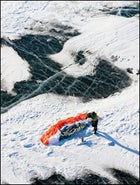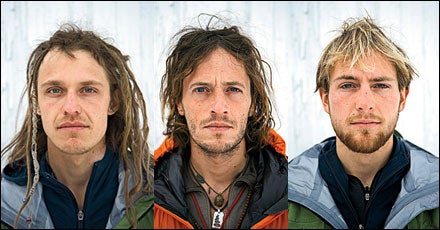Kite Ski Across North Dakota
 Preparing for liftoff on the Missouri River
Preparing for liftoff on the Missouri RiverSam, Jason, and Paul
 Sam, Jaso, and Paul
Sam, Jaso, and PaulIN CASE YOU’VE NEVER CHOSEN to visit North Dakota for a week in the dead of winter, let me assure you that it’s really tough to explain why any fully evolved Homo sapiens would. Here, just shy of the Canada border, as you’re about to check in to the lonely Golden Hub Motel, in the town of Crosby, all you hear is the squeak of your feet on snow, and no horizon delineates the frosty sky from thousands of acres of frosty fields. Staring at this desolate scene is like being in a very cold cloud, or how I imagine we might greet the white light of death. The question Why are you here? is soon followed by Why? Yes, it’s the kind of place that can drive a man to commit philosophy.
Speaking concretely, I’m here to follow the To Cross the Moon (2XtM) expedition, a second attempt by three buddies to traverse the lunar-looking state, powered only by wind. Jason Magness, 32, Sam Salwei, 26, and Paul Cassedy, 19, plan to use snowkites large parafoils clipped to hip harnesses via 80-foot lines to tow themselves on skis and snowboards across North Dakota’s farms, ranchland, and frozen lakes. Starting in the far northwestern corner, they’ll head south to 150-mile-long Lake Sakakawea, cross it, and then glide on down to SoDak. At the same time, a four-person education team will bounce around drumming up popular support for wind farms while a rotating roster of volunteer photographers and videographers (the “media crew”) documents it all.
��
When I catch up with the adventurers on their second day, Paul, a quiet kid who’s new to kite-skiing, is seated in a field of snow-dusted wheat stubble, his face hidden behind his helmet, balaclava, rime-covered neoprene mask, and fogged goggles. His mitts are frozen solid, so he paws dumbly at the lines, trying in vain to take flight. Then he finds the center line and pulls it to his chest, the kite inflates with a bang, and he’s off! In the wrong direction. Until he falls 50 yards away. Taking a divot out of the snow with his chin.
Nearby, Sam is having a blast. A puckish Crystal, North Dakota, native who’s kite-skied hundreds of miles, he swoops his rasta-themed kite directly overhead and launches six feet into the air: “Yoooooo!”
Jason, the group’s strongman, seems unfatigued, despite having run 70 miles in an adventure race just four days ago. He yells encouragement to Paul, who once again is in a crumple: “Let’s go, Paul! You’re only 19! You’ve got a lot more suffering ahead of you!” Jason then vaults skyward, imitating Sam. Before his skis leave the ground, however, his 50-pound pack tips backwards and turtles him.
��
Hard to believe, but their plan is to continue this way, self-supported, for 400 miles, in temperatures that will bottom out at minus 42. They will go farther on less food than I imagined possible, and they will tangle a kite high in the branches of the only tree in sight all without once doubting the tilting-at-windmills brilliance of their mission.
The question of how this expedition came about is difficult to answer, as is the question of how its members avoid the soup line. Sam, who’s lived in North Dakota most his life, and Jason, who lived there from 2000 to 2007, run a company called Yogaslackers, which has taught a few people how to do the warrior pose on a wobbly tightrope but, near as I can tell, has netted them very little cash, their Slackasana DVD not yet a blockbuster. They each earn a couple grand annually at odd jobs like modeling (Jason) and rigging rock arenas (Sam) but never more than is needed to get to the next yoga workshop or adventure race. They travel in a rattly, candy-apple 1989 Ford Festiva spray-painted with the words PEACE and LOVE. While their dreadlocks come and go, their toughness is a constant. Jason has completed 30 adventure races; Sam, a dozen; and Paul has done a few with other teenagers on a team called Barely Legal.
Sam came up with the Big Idea three years ago. His vague hope was that kite-skiing North Dakota would turn wind power into a topic of conversation in a state that gets 90 percent of its electricity from coal. And so he and Jason set off on an attempt last winter. The wind showed up, but the snow disappeared after just 12 days, forcing them to quit. That they would try again was a given undeterred, evidently, by the fact that North Dakota, cold though it is, averages only around 25 inches of snow annually. Paul, who’s not from the state but was part of the original support crew, decided that freezing his ass off looked like too much fun to miss.
This year, 2XtM hopes to raise the level of discussion by getting serious media coverage. To that end, the education crew is very much on-message, prepared to show that North Dakota is “the Saudi Arabia of potential wind energy.” (Not unlike Arizona, which has been dubbed “the Persian Gulf of potential solar power.”) For good measure, the expedition’s grub is organic vegetarian gooey raw-food power bars for lunch! and the team has turned down eight gear sponsors in favor of using earth-friendly equipment whenever possible. For example, Sam snowboards while wearing flimsy moosehide mukluks.
Despite these preparations, it’s apparent that some details have unraveled or were never quite tied up. Jason forgot the climbing skins that would allow him to cross-country- ski on breezeless days. The transmission on the media truck blew out, leaving the team without a chase car until a wind-enamored stranger offered to loan them his family’s Ford Expedition for two weeks!And, most notably, the guys did not scout the course. All they’ve got is the folding highway map given free to tourists. They have no idea where the hundreds of barbed-wire fences lie. Every time they come to the edge of a land parcel, they have to gather up their kites, unclick from boards and skis, neatly roll up lines and fold canopies, clamber through or around the fence, then repeat the process in reverse with hands so cold they might as well be tennis rackets.
LEAVING THE WARMTH of the Golden Hub Motel on day three, the videographer and I plan to use the 2XtM GPS with two-way radio to guide ourselves back to wherever the team is. But the guys either have forgotten to turn on their fancy device or have let the batteries die. And since we’re in no-bars country, we swing into the one-room post office in Alamo, hoping to use a landline to call the guys’ satellite phone.
Joanne, a middle-aged postal clerk with buggy glasses and curly red hair, asks if she can help. When I tell her we’re with 2XtM, she perks up she’s been following it in the local paper and online. “Are they coming through here?” she asks excitedly.
“I dunno,” I say.
Unprompted, she jumps on 2xtm.com, locates the team with the real-time-tracking tab, and says they’re between County Roads 130 and 129, north of 89.
Sure enough, we find them kiting near the road, just beyond a frozen reservoir thick with bushy cattails, in the middle of a fierce whiteout.
“The kite is like an angry kangaroo on the end of a string!” bellows Sam.
“We pitched our tent next to a chicken coop last night,” Jason tells me as he struggles to keep the team within sight of one another a difficult task, given that swirling ice vapor has already made me queasy with vertigo.
Paul says little, mumbling that he has spent the past hour crashing and rolling through thigh-high prairie grass.
At twilight they clomp into Alamo and happen to run into Joanne, who immediately invites them to stay the night at her house. They decline graciously. She offers to drive them to the nearest place where she can buy them a hot dinner. No, thanks. She offers to bring them a hot dinner. Thank you, but no. She insists they at least stay inside. They finally relent and spend a warm night in a church, kites drying on the pews.
Repeatedly smothered by the brown gravy of midwestern kindness, they will end up staying in another church, a stranger’s home, a Quonset hut, and a mobile home. Large meals will be set before for them, homemade cookies brought. A Hidatsa tribeswoman will organize a lakeside gathering of elders to cheer them on. The show of support is nothing less than flabbergasting.
WHILE THE KITERS sleep in the Alamo church, I swing by a library in the 12,000-person town of Williston to watch a presentation by the volunteer educators, who, all told, will spend six weeks crisscrossing the state on a budget of just $3,500.
Tonight’s turnout is decent: two youth groups, a few adults, and a local reporter. The presentation begins with a surprisingly cool video of kite-skiers catching big air and then shifts to a scary montage showing the effects of global warming. The speakers a produce manager at a food co-op and two undergrads take turns leading an interactive multimedia presentation, at one point asking the kids to write letters to the governor, before culminating with a staggering fact: North Dakota’s wind energy could meet one-third of the country’s electricity needs. But it currently provides only 2 percent of the state’s electricity needs.
Despite a few certifiably crackpot questions for example, “Didn’t the eruption of Mount St. Helens spew more greenhouse gases into the atmosphere than mankind has ever produced?” everyone seems genuinely interested in finding the best solution.
And it’s not just here. Ultimately, the education crew will speak to more than 7,000 people, while local newspapers, radio shows, and TV stations will cover 2XtM more than 40 times.
What will come of all this is hard to say. Enthusiasm for local wind power is growing slowly: a group of Benedictine nuns installed two turbines in west-central North Dakota to power their convent not long ago, and bigger projects are coming online as well. (State wind production doubled last year, thanks largely to Florida-based FPL Energy’s completion of a 106-turbine farm in northeastern NoDak.) But the coal industry is powerful, running ads daily on TV and radio, and harnessing the breeze fully will require costly new transmission lines to Minnesota and Chicago. The education crew knows they can’t take on the coal lobby directly, but, still, I can’t help but wonder if they wouldn’t do well with more than a token letter-writing campaign to lure politicians to their cause.
��
Unsurprisingly, 2XtM’s target= audience the students remains blasé. “Climate change is only news to people who don’t pay attention,” one high schooler informs me after the presentation.
“So what struck you most?” I ask.
“Getting 150 feet of air,” he replies.
Which, it turns out, isn’t that easy to do. Toward the end of the trip, the education crew offers me a kite-skiing tutorial. I’ve never done it before, but I can ski, and I can fly kites, and I can tumble end over end, so why not?
The lesson starts with just the kite, as they show me how to tilt the steering bar so that the kite swoops in large figure eights, pulling steadily on the climbing harness around my hips. Piece of cake! After a half-hour of practice, I borrow skis and boots and am soon skipping back and forth at nearly 20 miles per hour, leaning hard, dragging my knuckles like a pro. Tacking: no problem. Catching air: Maybe I’ll try that later. Heading any direction other than across the wind: painful.
As I try to angle upwind, back toward where I started, the kite luffs, I glide underneath it, and then it billows and pulls my lower body roughly opposite the direction of the skis. Every ligament in my knees strains with the twist and I collapse onto my elbow, only to be dragged across the snow-covered lake like an outlaw lassoed to a galloping horse. After a few more attempts, I crumple the thing up and shuffle back to the boat landing, convinced that snowkiting long distances is a bit like rodeo clowning: It’s kinda fun and funny, but a good day is when no one gets hurt.
WHEN I CATCH UP with the guys at dusk on day four, they’re dragging boards and skis down County Road 42. As usual, there are wind problems it’s either too light or coming from the wrong direction. Today, the team has already schlepped 18 miles on foot.
Singing a bawdy sea chantey, they remain positive even Jason, who has walked that 18 miles in ski boots.
“I like these experiences with highs where I think I’m Superman and lows where I’m depressed,” he muses.
“Yeah,” says Sam, “we can condense our bipolar tendencies into one month and then be normal the rest of the year.”
Not long before midnight, after walking nine more miles, they finally stumble into the town bar in Epping (pop. 79) looking gaunt, crater-eyed, and pale, like refugees.
“I’ll take a Coke,” Sam tells the waitress. “No ice.”
Upon hearing they’re part of 2XtM, the barflies ask tentative questions and gently tease the guys from their stool-top perches.
“Well, shoot, we can go get a towrope and I’ll hooky-bob you boys down to Sakakawea,” offers one.
“No, not now that we got all these damn signs on every road,” says an old-timer.
Indomitable Jason restores his strength and finds his center by performing vertical yoga poses near the pinball machine. Sam nurses his Coke, unable to eat for fear of throwing up. Paul gapes at his pepperoni pizza, the least meaty of the five pies on the menu, as if staring long enough will cause the greasy little disks of processed sausage to acquiesce to his vegetarian wishes and slither off the cheese on their own.
The rest of the expedition will continue apace. They’ll reach Lake Sakakawea two days later, only to discover that favorable winds have blown the snow right off the surface, leaving a foggy mirror. Sam, unable to hold an edge the way he could in the hard red spring wheat, will crash repeatedly, dislocate his shoulder, and take a fully supported detour to the emergency room. Paul will somehow find his stride and kite-ski better than Jason. “I’d think I was gonna die,” he explains obtusely, “and then I wouldn’t.” Jason will remain steady as he goes, until they near the Missouri River and see that there’s no snow. At all. Again. “We thought the expedition was over,” he says.
But no. Sam will borrow a mountainboard, a sort of knobby-tired skateboard, and two kite buggies, like adult Big Wheels, and they will keep on kiting and rolling toward South Dakota. Except when the wind dies. Or they descend hills. At which point they have to crash skillfully in the ditch to slow the brakeless contraptions.
On February 28, after six days of walking and 12 days of kiting, they’ll arrive in Keldron (pop. 127). They’ll consider it a success, because they made it and mostly because of the work of the educational crew, which capped its campaign with a blowout bash in downtown Fargo, featuring a mock campsite, looping footage of the event, and a lavish spread of food all still on that $3,500 budget, because a city commissioner took care of the costs. Apparently he happened to catch an earlier presentation, called the group afterwards, and asked how he could help. By now, I wasn’t the least bit surprised.


